Potential Drop across capacitor

Find the potential drop across capacitor
[hide=Try it!] Interesting Problem![/hide]
No vote yet
8 votes

Find the potential drop across capacitor
[hide=Try it!] Interesting Problem![/hide]
Easy Math Editor
This discussion board is a place to discuss our Daily Challenges and the math and science related to those challenges. Explanations are more than just a solution — they should explain the steps and thinking strategies that you used to obtain the solution. Comments should further the discussion of math and science.
When posting on Brilliant:
*italics*or_italics_**bold**or__bold__paragraph 1
paragraph 2
[example link](https://brilliant.org)> This is a quote# I indented these lines # 4 spaces, and now they show # up as a code block. print "hello world"\(...\)or\[...\]to ensure proper formatting.2 \times 32^{34}a_{i-1}\frac{2}{3}\sqrt{2}\sum_{i=1}^3\sin \theta\boxed{123}Comments
C1+C2C2(E1+E2)
Swap the positions of E2 and C2. You now have a simple voltage divider.
Log in to reply
swapping them won't make a difference?
can you please explain a bit more?
nice writing :D
In steady state, charges stored in the capacitors must be same. Then, we just have to apply Kirchoff's Law.
Log in to reply
Not only at steady state , but at all time instants charges stored in capacitors would be same.
Log in to reply
yes, of course.
how? can you explain a bit more?
Log in to reply
qcap.=0∫ticap.(t)dt. Since , icap.(t) is same for both capacitors ( as the circuit is complete ) , qcap. would also be same for both at any instant .I have assumed that initial charges of both capacitors is zero. (else the question would have been tidious and answer would have been a function of time.)